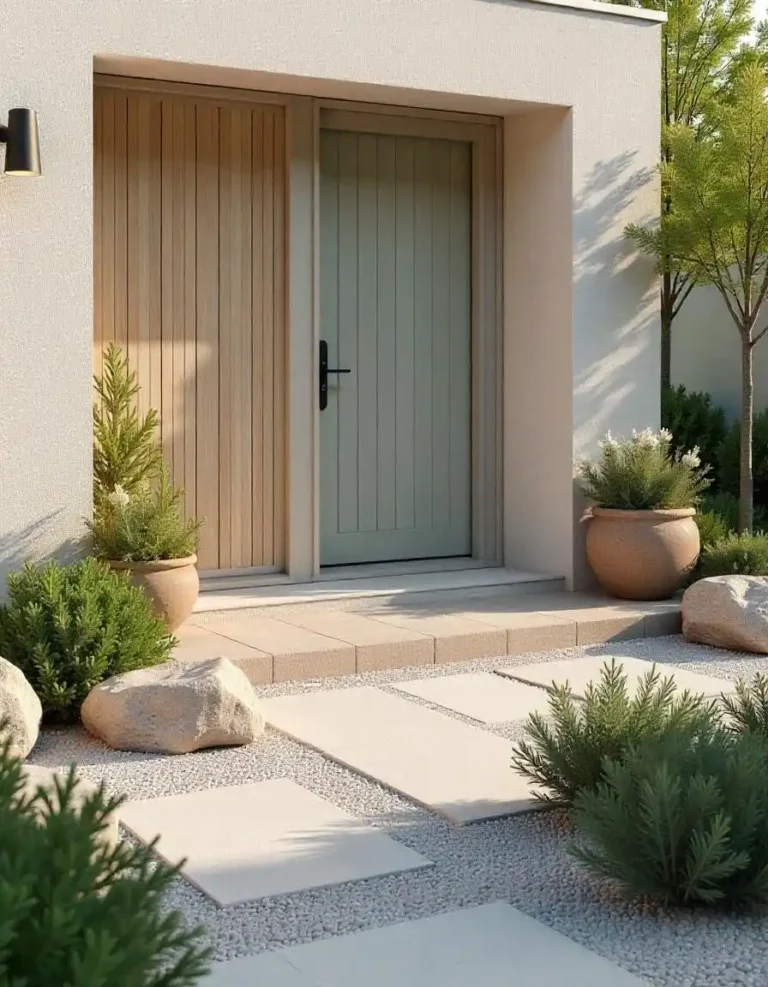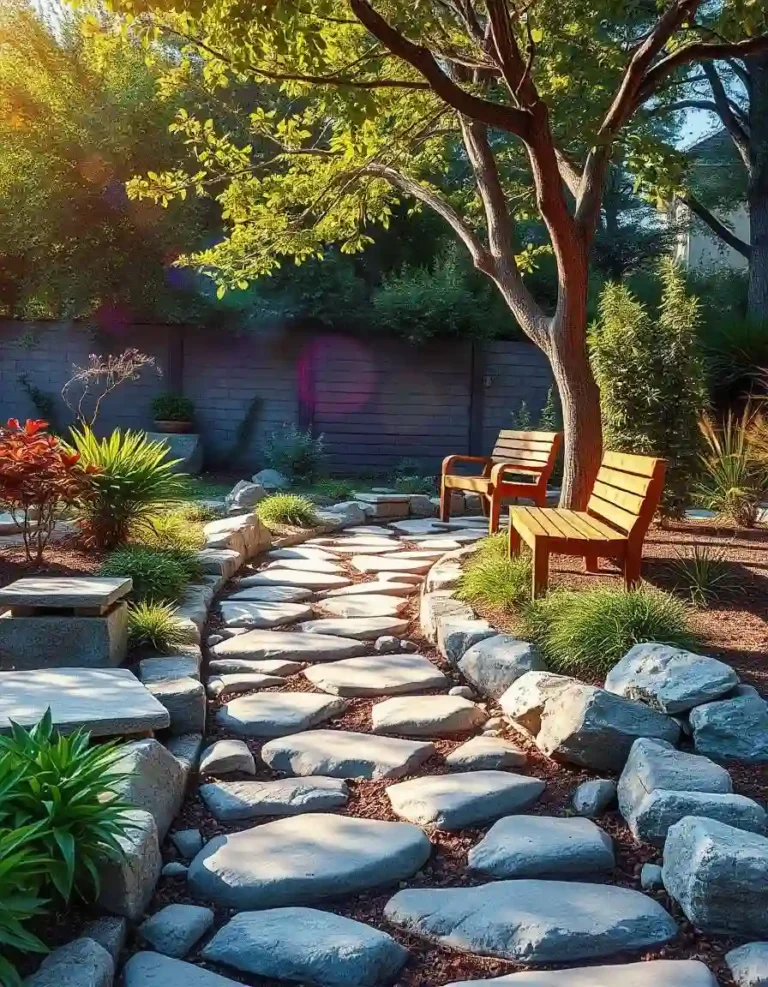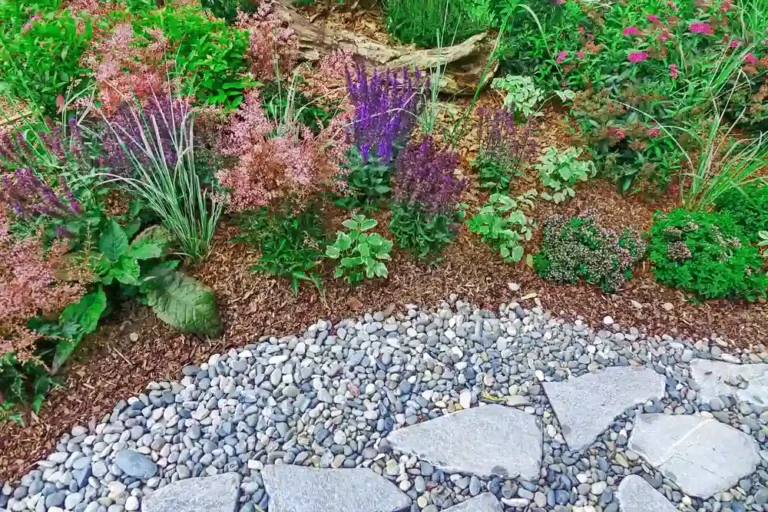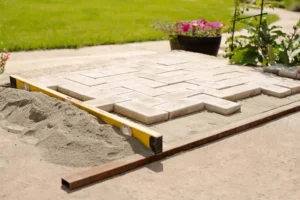Landscaping with rocks is a great way to create a beautiful, low-maintenance yard for homes and businesses. Instead of grass or plants, you can use different types of rocks like pebbles, gravel, and boulders to design unique outdoor spaces. This method is popular because it saves water, reduces maintenance, and works well with many styles, from modern to natural. Rocks also help prevent soil erosion, improve drainage, and add texture to your landscape, making them a smart and stylish choice.
How to Use Rocks in Your Landscape

Choosing the Right Rocks
When incorporating rocks into your landscape, selecting the right type is crucial to achieving your desired aesthetic and functionality. Different types of rocks offer unique benefits:
- River Rocks: Smooth and rounded, river rocks are often used for ground cover, water features, or as edging around garden beds. Their natural look works well in both modern and rustic landscapes.
- Flagstone: These flat stones are perfect for creating pathways, patios, or even stepping stones. They are available in various colors and sizes, making them highly versatile for different design styles.
- Gravel: Gravel is an affordable and low-maintenance option for driveways, walkways, or garden beds. It comes in various sizes and colors, allowing you to create a customized look that complements the surrounding plants and features.
- Boulders: Large and imposing, boulders make striking focal points in a garden or can be used to create dramatic stone walls or accents. They work well in natural or rustic landscapes and can also help with erosion control on sloped areas.
Planning the Layout
Integrating rocks into an existing landscape requires thoughtful planning to ensure that the rocks enhance the space rather than overpower it. Start by evaluating the size of your space and the existing design elements, such as plants, walkways, and structures. Consider the purpose of the rocks whether for practical reasons like erosion control or for purely aesthetic purposes. For a seamless integration, use rocks to define areas (e.g., creating a border around a garden bed or establishing a pathway) or complement other natural elements. Be mindful of the scale of the rocks in relation to the overall space to avoid making the area feel overcrowded or unbalanced.
Incorporating Rocks into Design Styles
Rocks can be incorporated into a variety of design styles, each bringing its own charm and character to your landscape:
- Natural: To create a natural, organic look, use a mix of different rocks and sizes that mimic the randomness of nature. Rocks can be placed casually to form meandering pathways, naturalistic water features, or stone borders that blend with wildflower meadows and native plants.
- Modern: A minimalist approach works well with rocks such as sleek flagstone or smooth river rocks, often used in geometric layouts or symmetrical patterns. The clean lines and simple design can create a polished, contemporary feel, especially when paired with minimalist plantings and other modern materials.
- Desert: For a desert-inspired landscape, opt for lighter-colored rocks like sandstones, pebbles, and gravel. These rocks can be used to create dry riverbeds, rock gardens, or low-maintenance xeriscape designs, complemented by drought-tolerant plants like succulents and cacti.
- Mediterranean: Mediterranean landscapes often incorporate stone elements, such as terracotta-colored flagstone or stacked stone walls. These rocks pair beautifully with fragrant herbs, olive trees, and other Mediterranean plants, creating a warm and inviting atmosphere.
- Rustic: Rocks in their raw, natural state such as large boulders or fieldstones work well for rustic designs. These can be used to form stone fences, retaining walls, or natural seating areas, bringing an earthy and timeless quality to the landscape.
Creating Rock Features
Rocks can be the centerpiece of your landscape design, serving both functional and aesthetic purposes:
- Pathways: Use flagstone or stepping stones to create winding paths through your garden or yard. These can lead visitors through lush plantings or connect different areas of the landscape. A well-placed stone pathway can also add texture and visual interest to otherwise empty spaces.
- Walls: Stone walls can be used for retaining purposes or as decorative features. Whether stacked in a dry-laid style or mortared for greater stability, walls can define spaces, provide privacy, and add a sense of structure to the landscape.
- Water Features: Incorporating rocks into water features like fountains, ponds, or streams can add both visual appeal and soothing sound to your landscape. Large stones can form the foundation for a cascading waterfall, while smaller rocks can be used for decorative accents around the water’s edge.
- Focal Points: Large boulders or unique rock formations can serve as striking focal points in your landscape. Whether positioned in the center of a garden bed, placed next to a water feature, or used as standalone sculptures, rocks can draw attention and create a sense of drama and elegance in your outdoor space.
Benefits of Landscaping With Rock

Low Maintenance
One of the major benefits of landscaping with rocks is the minimal maintenance required. Unlike plants and lawns that need regular watering, trimming, fertilizing, and pest control, rocks are virtually maintenance-free. Once laid down, they do not need to be replanted, pruned, or tended to, making them an ideal choice for homeowners or property owners looking to reduce upkeep time and effort. This low-maintenance feature is especially beneficial in busy environments or for people seeking a more hands-off approach to landscaping.
Durability
Rocks are incredibly durable and can withstand a variety of weather conditions. Unlike plants, which may wither in extreme temperatures or suffer from disease, rocks maintain their integrity throughout the year. They are resistant to fading, cracking, or damage caused by heat, rain, or snow, ensuring that your landscape design remains intact for years. The longevity of rocks makes them a solid investment for landscaping that lasts.
Water Conservation
In regions facing water scarcity or for those looking to conserve water, rocks can significantly reduce water usage. By replacing lawns and water-intensive plants with rocks, the need for frequent irrigation is minimized. Rocks help maintain moisture in the soil by preventing excessive evaporation and can reduce the overall water demands of the landscape. This makes rock landscaping an eco-friendly choice, especially for xeriscaping and sustainable garden designs.
Erosion Control
Rocks play a key role in preventing soil erosion, particularly in areas with slopes or heavy rainfall. By strategically placing rocks such as gravel, boulders, or stone walls, you can stabilize the soil and prevent it from washing away. This is particularly beneficial on hillsides, garden beds, and waterfront areas where water runoff could cause damage. Rocks help maintain the integrity of the land while promoting healthier soil retention.
Aesthetic Appeal
Rocks bring natural beauty and texture to any Bay area landscape design. With their variety of colors, shapes, and sizes, rocks can add contrast and visual interest to your outdoor space. They can create a rustic charm or modern elegance, depending on your design preferences. Rocks can be used to highlight specific features like pathways, garden beds, or water features, adding depth and sophistication to the overall design. Whether used as ground cover, as part of a feature, or as decorative accents, rocks enhance the visual appeal and create a timeless look in the landscape.
Landscaping with Rocks Ideas
Rock Garden Designs
- Layered Rock Gardens: Stack various sizes of rocks to create a natural, cascading effect. You can plant drought-tolerant plants like succulents or cacti between the rocks for a low-maintenance yet visually stunning garden.
- Zen Rock Gardens: Use smooth stones, pebbles, and sand to create a minimalist, meditative space. Arrange the rocks in patterns and rakes the sand to mimic waves, offering a peaceful and visually calming atmosphere.
- Rock-Centric Planting Beds: Surround plants with larger stones to create a more defined garden space, creating contrast between the vibrant colors of the plants and the muted tones of the rocks.
Rock Pathways and Walkways
- Stepping Stones: Arrange large, flat stones in a stepping stone pattern to create a rustic path. Plant ground cover like moss or thyme between the stones for a natural, seamless look.
- Gravel Walkways: Lay down a gravel path bordered by larger rocks to prevent the gravel from spreading. This type of pathway adds texture and is easy to install and maintain.
- Cobblestone Paths: For a more elegant, old-world look, use cobblestones to form a pathway. Their irregular shapes and earthy colors complement a variety of garden styles, from traditional to modern.
Rock Water Features
- Rock Fountain: Install a natural stone fountain with water cascading over large, irregular stones. The sound of the water flowing will create a peaceful atmosphere and bring life to the garden.
- Rock Ponds: Create a pond surrounded by large, smooth stones to mimic a natural water feature. You can add aquatic plants and small fish for an added touch of life.
- Waterfall with Rocks: A waterfall built from stacked rocks can be the focal point of your garden, offering a soothing sound while providing a lush, tranquil environment.
Rock Retaining Walls
- Dry Stack Walls: Create a dry stack wall using flat stones to prevent soil erosion on sloped areas. These walls can be used for terracing, dividing garden areas, or simply adding architectural interest to your landscape.
- Natural Stone Blocks: Use large stone blocks for a more structured retaining wall. This can be ideal for creating raised garden beds or leveling out different sections of your yard.
- Rock Garden Terraces: In areas with heavy slope, build multiple retaining walls using different types of rocks to form tiers for plants and flowers, adding dimension and beauty to the landscape.
Fire Pit Areas
- Surround with Stone: Build a circular or square fire pit using large, heat-resistant stones. Surround the fire pit with smaller rocks or pebbles for added texture.
- Stone Seating: Create built-in seating around the fire pit by using natural stone benches or using large rocks as informal seating areas for gatherings.
- Rustic Rock Ring: Place a ring of stones around the fire pit to contain the flames while adding a rustic, organic look. You can combine this with surrounding gravel or wooden accents for a cozy and inviting atmosphere.
Rock Mulch
- Pebble Mulch: Replace traditional organic mulch with small pebbles or gravel. This type of mulch can help retain moisture, prevent weed growth, and add a polished look to plant beds.
- Rock Garden Mulch: Use larger rocks or crushed stone around plants in your rock garden to mimic a more natural setting. This also helps with drainage, which is especially beneficial for succulents and other drought-resistant plants.
- River Rock Edging: Use smooth river rocks along the edges of flower beds as a decorative border. They help keep mulch in place while adding visual appeal and contrast against the plantings.
By incorporating these rock-based landscaping ideas, you can create an outdoor space that is both functional and visually stunning. Whether you prefer the simplicity of a Zen garden or the boldness of a rock wall, stones can offer endless design possibilities to enhance your landscape.
Low-Maintenance Landscaping with Rocks

Landscaping with rocks is an excellent way to reduce maintenance time and costs while creating a visually appealing outdoor space. Here are several ways rocks contribute to a low-maintenance landscape:
Choosing Drought-Tolerant Plants for Rock Landscaping
Integrating drought-tolerant plants into a rock garden is one of the most effective ways to ensure a low-maintenance landscape. These plants are well-suited for areas with limited water availability and require minimal attention once established. Some great drought-tolerant plants that pair well with rocks include:
- Succulents: Varieties like Sedum, Echeveria, and Agave thrive in dry, rocky environments.
- Lavender: Known for its resilience in arid conditions, lavender also adds fragrance and color to rock gardens.
- Russian Sage: This hardy shrub is perfect for dry, rocky areas and offers beautiful purple blooms.
- Thyme and Oregano: These groundcovers provide both function and aesthetic appeal, growing well in rocky terrain.
- Yarrow: A native perennial that requires little water and is attractive in a rock garden.
These plants, paired with rocks, reduce water usage, minimizing the need for irrigation while providing color and texture to your landscape.
Creating a Xeriscape with Rocks
Xeriscaping is a water-efficient landscaping technique that focuses on reducing water use by incorporating drought-tolerant plants and efficient irrigation practices. Rocks play a vital role in xeriscaping by:
- Retaining Moisture: While rocks don’t hold water like mulch, they help regulate soil temperature and moisture retention, reducing evaporation.
- Minimizing Watering: With the use of drought-tolerant plants and rocks, you can design a landscape that needs less water, which is especially beneficial in areas facing water restrictions or drought conditions.
- Reducing Lawn Area: In xeriscaping, rocks replace grass or sod, which typically requires frequent watering and maintenance. Rock paths, dry creek beds, and rock walls can replace traditional lawns.
Incorporating native plants and strategically placing rocks in areas that get full sun can reduce the need for irrigation, creating a sustainable, beautiful landscape.
Less Weed Growth
One of the major advantages of using rocks in landscaping is the significant reduction in weed growth. Unlike soil-based landscaping, where weeds can easily sprout and spread, rocks provide a natural barrier that:
- Blocks Sunlight: When placed on top of landscaping fabric or soil, rocks prevent weeds from getting the sunlight they need to grow.
- Reduces Soil Disturbance: Rocks help keep soil compacted, making it harder for weed seeds to take root.
- Minimizes Maintenance: Less weed growth means fewer hours spent pulling weeds or applying herbicides.
Using a layer of landscaping fabric beneath the rocks further improves weed control, ensuring your rock garden stays tidy with minimal effort.
Easy-to-Clean Surfaces
Unlike mulch or soil-based landscapes that can get messy, rocks provide an easy-to-clean, durable surface. Here’s why rocks are superior for low-maintenance cleaning:
- No Need for Raking: Rocks don’t decompose or need to be replenished like mulch, so you don’t need to worry about raking or refreshing the surface regularly.
- Effortless Cleaning: After a storm or a season, simply using a broom or hose can remove dirt or debris from rocks, making maintenance straightforward.
- Pest-Free: Rocks do not harbor pests, unlike organic mulch, which can attract insects, rodents, or mold.
Final Thoughts
At Lakota Design Group, we believe that landscaping with rocks offers an exceptional solution for creating a beautiful, sustainable, and low-maintenance outdoor space. By combining drought-tolerant plants, strategic rock placements, and water-efficient designs, we help our clients create landscapes that require less upkeep while enhancing their visual appeal. Whether you’re looking to reduce weed growth, create a xeriscape, or enjoy the effortless beauty of easy-to-clean surfaces, rocks provide a durable and practical choice. With our expertise, Lakota Design Group is dedicated to designing landscapes that are not only stunning but also environmentally friendly, allowing you to spend less time on maintenance and more time enjoying your outdoor oasis.





